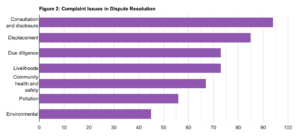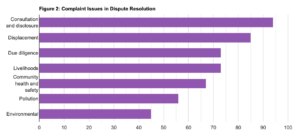How Should IAMs Choose Mediators?

Mediators are impartial third parties who help facilitate the dispute resolution process. Given the
significant power imbalance between communities and bank clients, a mediator’s role in an IAM
dispute resolution process is often critical to reaching an agreement.
Solving complaints through mediation
Independent Accountability Mechanisms (IAMs) are established by financial institutions to ensure compliance with applicable environmental and social safeguards, and to facilitate communication with affected communities and individuals with a view to resolving project-related disputes. Most IAMs address complaints from affected communities through two processes: dispute resolution and compliance review.
Dispute resolution (sometimes referred to as mediation, problem solving, or consultation) is a voluntary dialogue process facilitated by the IAM in which the parties seek mutually agreeable solutions to the concerns faced by the complainants. The parties involved in dispute resolution are typically communities (the complainants) and bank clients or project implementers, but can also include bank staff, government officials, and other stakeholders or responsible actors. IAMs often hire independent mediators, who are impartial third parties, to help facilitate the dispute resolution process. Of all eligible complaints to IAMs, 29.2% undertake dispute resolution.

Figure 1: The Accountability Console defines a dispute resolution outcome as “successful” when the
dispute resolution process results in an agreement, and “unsuccessful” when a dispute resolution
process does not result in an agreement. It is noted that the “success” of a dispute resolution
outcome does not reflect whether communities have had their concerns adequately addressed or
whether they themselves would define the process or the agreement as a success.
Elements of Mediation
A mediation process is guided by a few elements, including:
Impartiality
Mediators are required to be impartial and independent of the parties. We interpret impartiality to require the mediator to practice fair and equitable treatment (as opposed to equal treatment) to create the conditions for the effective engagement of all parties in the process.
Voluntary participation
A successful mediation requires all parties to engage with the process in good faith at all stages, and genuinely attempt settlement together. This means that mediation cannot guarantee certainty of result; if the parties cannot or do not agree, a mediation will not result in an agreement. Success, then, requires trust in both the mediator and the process.
Party autonomy and flexibility
In mediation, parties are empowered to determine the issues raised for discussion as well as the outcome of the mediation. This means that mediation processes are essential for enabling impacted communities to propose their own solutions and remedial actions to resolve the impacts they face. While IAMs and mediators can, and often should, play an active role in helping parties generate creative solutions and remedies, the dispute resolution function should not impose particular outcomes on complainants. Solutions within the mediation process should ultimately be driven by the parties themselves. That said, the mediator does still play an important convening role, with a major influence on format, timing, rules of participation, agenda-setting, and responding to issues that arise.
Power disparity in IAM processes
It is unlikely that power will ever be equally balanced between parties to a dispute, however in IAM complaints there is generally a significant imbalance of power. In IAM complaints, local communities complaining of harm face bank clients, project implementers, and even financial institutions, who wield far greater material and legal resources, technical information, bargaining power, and political authority.
What does the data show?
This huge power disparity in IAM complaints is evident in the data. Out of the 177 complaints that have undertaken dispute resolution, 48.0% (85 complaints) show project-affected people complaining about issues of displacement (physical and/or economic), 41.2% (73 complaints) about livelihoods issues, and 37.8% (67 complaints) about community health and safety.

The very people made insecure by a project must then devote time and resources to engage in a dispute resolution process. These communities are often opposing projects in highly funded sectors, and companies that have a lot of material resources invested in these projects. Out of 177 complaints, 57.0% (101 complaints) were raised in relation to projects in the infrastructure sector (a sector that sees well over $2.5 trillion in investments annually), and 21.4% (38 complaints) were raised in relation to projects in the extractives (oil, gas and mining) sector.

The role of the mediator in mitigating power imbalance
In situations with critical imbalance of power, such as in IAM complaints, the role of the mediator becomes very significant to the success of the process. An astute, experienced, community-oriented mediator can detect the power imbalances and intervene to reduce how much this imbalance hinders a mediation. Mediators are often critical to the parties’ ability to reach an agreement.
The Good Policy Paper: Guiding Practice from the Policies of Independent Accountability Mechanisms, examines policy provisions currently in place at IAMs from the perspective of communities using them, and identifies provisions that constitute good practice using the UN Guiding Principles on Business and Human Rights effectiveness criteria for grievance mechanisms. In recognition of the power imbalance inherent in these complaints, the Good Policy Paper (GPP) notes:
“Any dispute resolution between the complainants and clients of the financial institution, and indeed the financial institution itself, should ensure the application of a set of protections to ensure fairness, legitimacy and trust throughout the process. For example, the IAM should educate both parties about the rights project-affected people have with an eye to ensuring any resolution reached is compatible with those rights. The dispute resolution should be handled by an independent mediator or facilitator agreed to by parties, and the mediator should be empowered to support the parties differently, in line with their respective capacity, access to information and other resources, and ability to participate.”
The Good Policy Paper also states:
“While maintaining its impartiality, the dispute resolution function should seek to ameliorate the power imbalances between the parties. Parties to mediations generally do not have equal resources, capacity, political power, and information regarding the issues at hand. Mediators may have to support the parties differently in order to ensure both may participate effectively and on equal terms in the process.”
Mediating tactics
Mediators in IAM dispute resolution, then, must be experienced in facilitating discussions in disputes involving considerable asymmetries between the parties. Mediators can employ a wide range of mediating tactics to address the deep-seated disparities in power or information throughout the mediation process. Further, the Good Policy Paper observes that “mediators can and often should play an active role in helping parties generate creative solutions and remedies” as well.
Information sharing and technical support
One of the most important tactics that should be undertaken by a mediator to mitigate power imbalance is that of information sharing and facilitating access to technical support.
Due to the huge power disparity in IAM complaints, aggrieved communities often do not have access to the same information as the bank client or project implementer, and may not know to ask for that information. Since dispute resolution is a voluntary process that requires parties to engage in good faith to reach a settlement, a mediator must help parties gain access to relevant data and information – in a language and format that is accessible to community representatives – in order to have both parties start the process on the same footing.
Communities often do not have access to the same technical support either. A mediator, then, can facilitate access to technical support, including civil society support, negotiation skills training, or access to technical experts, depending on the situation.
Preventing harm
In addition, in an IAM complaint process, a mediator can and should intervene to prevent or stop harmful conduct, including the stigmatisation of communities or other offensive behaviour that can escalate to retaliation or reprisals against the community.
Other tactics
A mediator can employ a variety of other tactics to address power disparities in these processes, including determining the structure of discussion, controlling the duration of time each person may speak, and choosing to use joint and/or separate sessions, or specific ground rules. Thus, through the use of a range of tactics, mediators can and should mitigate power disparities at various points in the mediation.
Online formats
It is noted though, that many of these tactics have been more complex to employ in recent years. Since the 2020 pandemic, mediation, like most other processes, was forced to jump to fully online formats with facilitation through videoconferences. This has in turn resulted in minimising the use of relevant tools and techniques, such as “humor, short remarks or questions, using visuals through drawings or flow charts that are improvised on the spot, and even forms of subtle ‘framing’ when the chat has not been successful as a communication channel and the facilitator wants the speaker to conclude or finish making a point.”
The online format has also made building rapport and trust between the parties more difficult, since nonverbal language and emotional cues are drastically reduced (e.g. lack of eye contact, time lags), ambiguity is increased, and there is a loss of informal opportunities for rapport building. Restrictions on access to the internet or not having the necessary bandwidth can also deepen asymmetries between the parties. Thus, a mediator working in online formats must build rapport and address disparities with these limitations in mind.
How are mediators chosen?
When selecting a mediator, the IAM must consider a variety of factors, including but not limited to: the nature of the complaint, the personalities at the table, community dynamics, the political atmosphere surrounding the complaint and whether a mediator has extensive experience working with communities or within power imbalanced relationships. Not every mediator is the right fit for every IAM mediation process.
Criteria
Although the mediator is integral to the success of a mediation, there is a lack of information in most IAM dispute resolution operating procedures about the criteria used to add mediators to a roster, and to select mediators for certain complaints. Most operating procedures generally indicate that IAMs select mediators on the basis of their “knowledge and/or expertise”,* “independence, neutrality and impartiality”,** and “an ability to understand cultural context”*** Publicly available IAM complaint documents also do not provide further information about the mediators.
Although some IAMs publish their terms of reference for joining their rosters (e.g. MICI), increased transparency in this area is required from most IAMs that do not publish what the required credentials, knowledge, and background experience is to join their rosters. Across IAMs there is also no publicly available information on whether mediators are reviewed after each mediation, whether community feedback is sought after each mediation, whether mediators can be struck off rosters or removed from a mediator pool, or how conflicts of interest are recognised and dealt with.
Party agreement
The Good Policy Paper advises that when a mediation is undertaken, parties should be provided the opportunity to agree to the mediator choice. While some IAMs have policies that allow parties to agree or object to the choice of the mediator by the IAM,**** not all do. Even IAMs that do have these policies, however, do not always consult with communities early enough in order to properly engage this policy.
It behooves IAMs to provide communities with sufficient time to consider and discuss proposed mediators. Mediator profiles should be provided to parties with adequate time and space to choose a mediator, ensure community voices are heard, and that all sides buy into the mediation. IAMs can provide these options alongside their preferences for specific mediators and the reasons for these preferences (e.g. a mediator’s background experience, or mediation style).
Consulting with communities at an early stage helps build trust in the process and the mediator, increases communities’ agency in the complaint process, provides parties the space to reject a choice or propose alternatives without risking delaying the process or adding to the costs, and is a signal to communities of the IAM acting in good faith. This consultation also increases the probability that the mediator chosen is the right fit for the community and political dynamics at hand.
Sensitivity to power dynamics
In addition to the mediators themselves being critical in mitigating power dynamics, IAMs must also be sensitive to power dynamics when choosing a mediator.
For instance, a community may view a local mediator as susceptible to compromise within their role, due to relationships or connections to an untrustworthy government. In that case, the community may actually prefer to choose a non-local mediator rather than a local mediator.
Similarly, women in the community may feel more comfortable and safer raising certain issues with a female mediator. Providing a mediator who could promote gender inclusion then, would allow for a more multifaceted understanding of the complaint and the community concerns.
Thus, consulting with communities prior to choosing a mediator allows community-, country-, and power-dynamics to be accounted for in these choices. In return, this consultation then creates the space for parties to enter into a mediation with good faith and a desire to attempt settlement together.
Conclusion
IAMs can play a critical role in improving meaningful outcomes within their dispute resolution processes by setting good policies and implementing best practice when choosing a mediator.
In addition, IAMs should increase access to data and transparency of their practices, including in relation to the criteria used to add mediators to a mediator roster, in what instances mediators can be removed from a mediator roster, and whether any record is kept of mediators that have produced “successful” outcomes versus ones that haven’t. IAMs should ensure that feedback is sought from communities about their experiences with particular mediators after each mediation, and these communities should be empowered to evaluate whether the process was successful for them regardless of whether the parties reached a settlement or not.
Finally, having more information about the mediators that have worked on certain cases, why they were selected for these cases, and how the community found those mediators to be, can help us understand further what makes certain dispute resolution processes successful or unsuccessful.
Endnotes
[*] See para 9 of WB DRS Interim Operating Procedures, para 73 of IFC/MIGA Independent Accountability Mechanism (CAO) Policy, and para 2.5.4 of EIB Complaints Mechanism Procedures.
[**] See para 73 of IFC/MIGA Independent Accountability Mechanism (CAO) Policy, and para 2.5.4 of EIB Complaints Mechanism Procedures.
[***] See para 9 of WB DRS Interim Operating Procedures, and para 73 of IFC/MIGA Independent Accountability Mechanism (CAO) Policy.
[****] See para 9 of WB DRS Interim Operating Procedures, and para 3.2.6 of FMO/ DEG/ Proparco’s ICM Policy.

